Menu
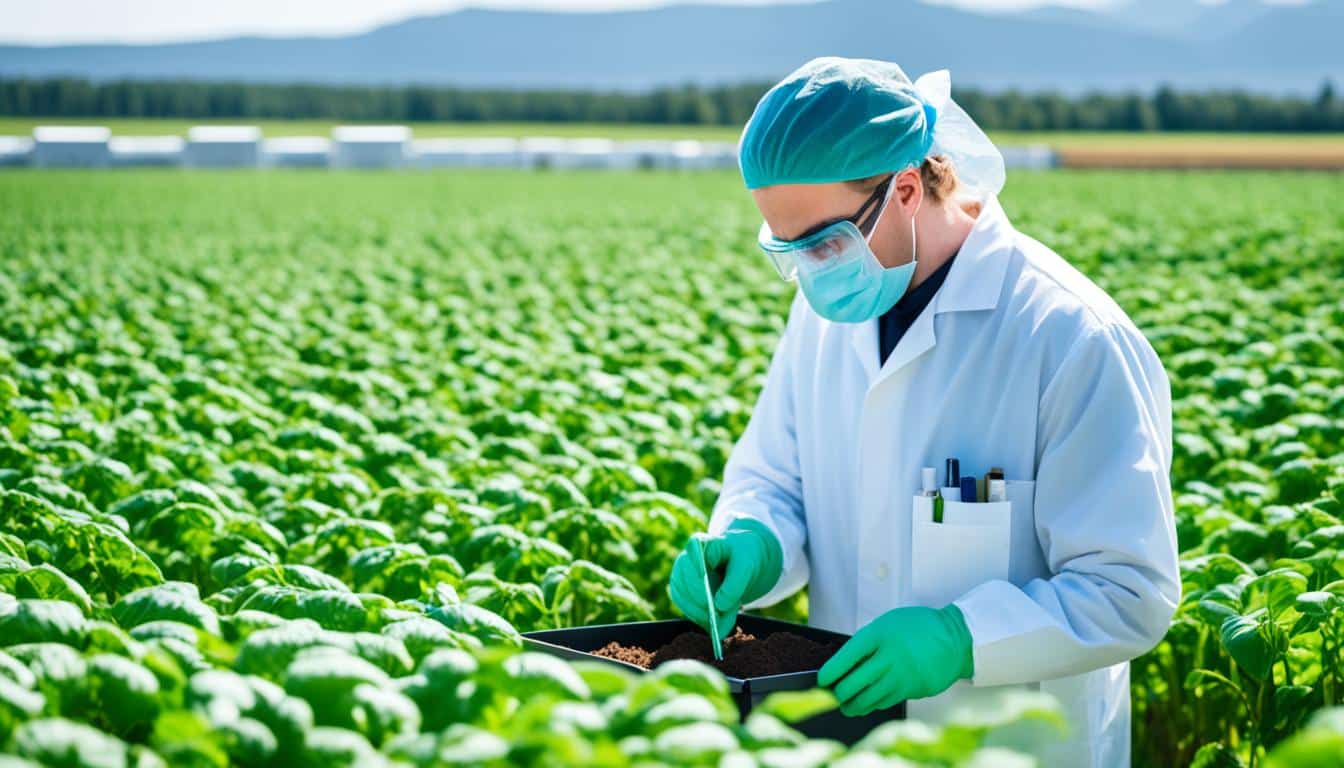
Did you know the global agricultural market is on track to jump from USD 81.5 billion in 2023 to USD 94.3 billion in 2024? This huge growth shows the importance of market research in agriculture. It helps us understand and manage fast changes. Market research gives us agricultural insights. These are crucial for farmers, agribusinesses, and policymakers to make smart choices about selling and distributing.
USDA Market News has been key for over 100 years. It gives out essential data on prices and sales. This data includes details on pricing, sales volume, value, and how the weather affects farming. Knowing about farming trends is vital in such a competitive and ever-changing field. It not only helps, but it’s a must for those who want to do well.
Understanding market dynamics in farming is essential. Prices change, demands shift, and crops produce differently each year. This makes market research key. It lets those in the industry predict trends, adapt to changes, and choose wisely.
Market research’s key role lies in its ability to offer detailed insights. Especially through surveys like CATI and CAWI. These tools help gather reliable data on market size, trends in machinery, and the major players. Such information is vital for spotting new chances and knowing the competition. It empowers firms to keep up their competitive edge.
| Region | Focus Area | Key Insights | Market Penetration |
|---|---|---|---|
| Africa / Middle East | Agriculture/Agribusiness | Farmers, Agricultural Producers | High |
For farmers, good market research can be a game-changer. It offers them expert insights and data. Research entities, like Fieldstat, help farmers see challenges clearly. They assist in developing smart strategies. This is especially helpful in places like the Polish countryside.
Furthermore, this type of research aids in finding potential buyers and learning their preferences. With this insight, farmers can better match their production and marketing. The result is wiser economic choices and lower risks.
Agricultural market analysis uses a wide lens to study the farming world. It focuses on two big parts: prices, and the size and weather’s effect on crops.
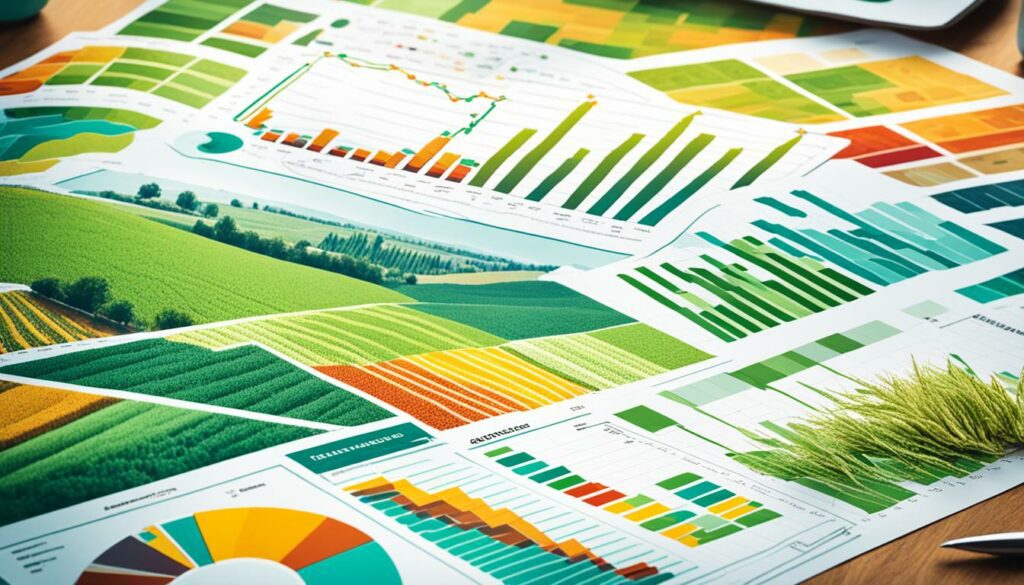
Grasping price and volume metrics is key to understanding farming markets. These details help spot trends by looking at price changes and how much is produced. With this info, farmers and others can plan better.
| Commodity | Avg. Price (USD) | Volume (Metric Tons) |
|---|---|---|
| Corn | 250 | 2,000 |
| Wheat | 200 | 1,500 |
| Soybeans | 300 | 1,800 |
Weather plays a huge role in how crops turn out and what they cost. Bad weather, like droughts, floods, or unusual rain, can hurt how much is grown. This leads to fewer goods and higher prices. Looking at past weather and crop data can help predict and manage these risks.
Today, tools like satellite photos and advanced weather forecasts make understanding these risks easier. They help farmers and experts plan better and lessen the impact of bad weather.
To do good market analysis, we need to look at prices and how weather affects farming closely. Both are important for making smart plans that boost farming success and profit.
For over a century, USDA Market News has been key in agricultural market research. It offers critical data on farm products. This data is vital for making farming decisions and for business strategies.
The USDA Market News began with price reports. Now, it covers a lot more, meeting both local and global needs. It has become even more important during the COVID-19 crisis, supporting local food systems.
This agency is great at gathering and sharing farming data. Reporters go to livestock auctions to get sales details. Millions get this info every day, making it widespread in the farming world.
The USDA also works to improve the farm supply chain. It supports local and regional markets, aiming to boost profits for farmers. This improves market conditions for everyone.
The USDA is also strong on the green front. It supports the use of sustainable fuel and biobased products. These efforts offer farmers new chances to compete in the market.
They also offer a big fund for projects using environment-friendly farming. This shows the USDA’s focus on giving out relevant and useful farming data.
| Programme | Focus | Investment |
|---|---|---|
| Sustainable Aviation Fuel Grand Challenge | Biobased Products Development | Various Initiatives |
| BioPreferred Program | Purchase and Use of Biobased Products | Ongoing |
| Wood Innovations Program | Biobased Products Innovation | Ongoing |
| Partnerships for Climate-Smart Commodities | Market Opportunities for Climate-Smart Practises | Up to $1 Billion |
USDA Market News is a crucial resource for American farmers, even those miles away. Its broad reach ensures farmers get the data they need. This helps them stay competitive.
Getting the right information about farms helps make smart decisions and boost how much we produce. We use both direct farm data and info from other sources. Today, high-tech tools also play a big part in collecting data for farms.
Primary data comes straight from the field. This includes talking to people, doing surveys, and having group discussions. Good Natured Family Farms in Kansas City did a big study on what consumers like about meat. They used interviews and surveys to get their answers.
Secondary data is info already published somewhere. This can be from reports, government databases, or industry news. It’s easier than going out and asking people. Farmers can find this data by working with experts, checking extension services, and searching online.
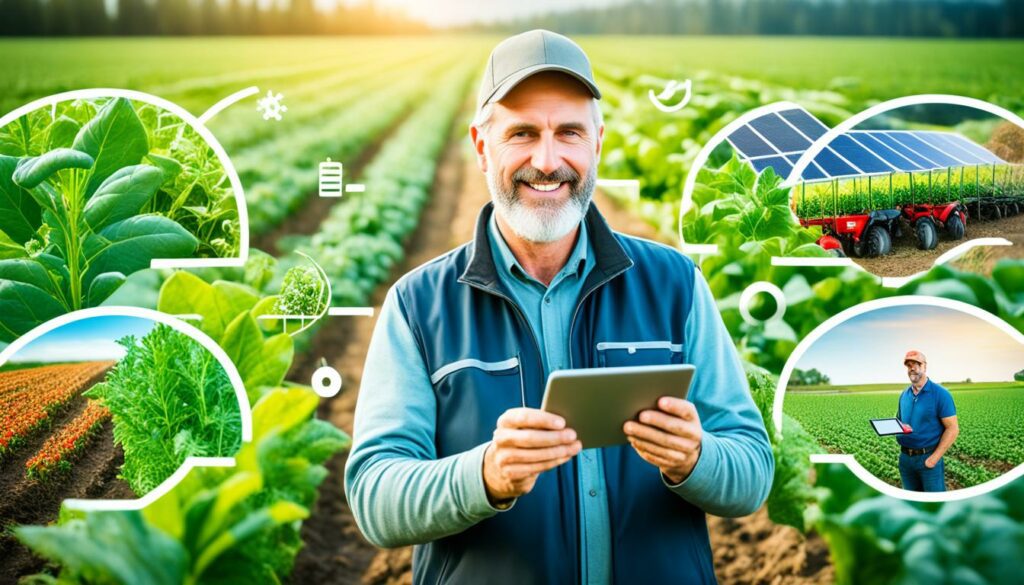
Today, technology has changed how we get data from farms. Devices that connect to the Internet and satellites help a lot. They give data quickly, which helps farmers make decisions fast. For instance, sensors on the farm can check how moist the soil is or how healthy the crops are. This helps farmers know what actions to take.
| Method | Tool | Purpose |
|---|---|---|
| Primary | Surveys | Gathering quantitative data such as consumer preferences and price sensitivity |
| Primary | Interviews | Exploring in-depth consumer behaviours and motivations |
| Secondary | Published Reports | Collecting information on market trends and industry standards |
| Secondary | Government Databases | Accumulating agricultural statistics and economic data |
| Technology | IoT Devices | Real-time monitoring of farm operations |
| Technology | Satellite Imagery | Assessing crop health and soil conditions |
Crop prices change because of things like the time of year, how much people want them, and world trade. Knowing these trends helps farmers and traders make good choices. The United States Department of Agriculture (USDA) and the National Agricultural Statistics Service (NASS) provide important data.
Seasons have a big effect on what crops cost. There is often a pattern of low prices when crops are first harvested, which then rise. Farmers use this knowledge to plan well. The NASS helps predict crop prices through its data collection.
Starting in May, they discuss upcoming winter wheat crops. By July, they move on to spring wheat and other grains, and in August, they talk about spring crops. The World Agricultural Outlook Board (WAOB) also helps by predicting the supply and demand of crops in the US and the world.
The June Agricultural Survey talks to 125,000 farmers. It finds out how many crops they planted, plan to plant, and how much they expect to harvest. This helps in making good economic choices.
| Month | Crop | Forecast |
|---|---|---|
| May | Winter Wheat | Initial Yield and Production |
| July | Spring Wheat & Small Grains | Production Updates |
| August | Spring-Planted Crops | Harvest Forecasts |
Understanding these factors helps in guessing when supplies might change and what prices might do. After harvest, there’s often more crop available, so prices might drop. To avoid this, some buyers pay more upfront. This shows how important it is to keep updating our knowledge through surveys and analysis.
Looking at livestock industry numbers helps us see trends and how much people eat. This helps guess how farming might change the economy, letting people in the field make smart choices.
In the next few years, the Farm Animals Healthcare market is expected to grow by 4.66% yearly. Meanwhile, shipping livestock by road is growing around the world. This shows big eating habits, mainly in places that rely heavily on livestock foods.
The aim in the Global Automated Feeding Systems market is to hit $5.6 billion by 2030, with a 5.1% annual growth. The U.S. Animal Food Manufacturing industry is looking ahead to 2028 to see what risks they might face. These predictions shed light on the big economic changes in farming and how being ready can help businesses grow, even in a shaky market.
| Market Segment | Growth Rate (CAGR) | Forecast Period |
|---|---|---|
| Farm Animal Healthcare | 4.66% | 2024-2032 |
| Hemp Beer | 6.05% | 2024-2032 |
| Global Animal Wound Care | 6.3% | 2024-2030 |
| Global Animal Antibiotics | 4.4% | 2024-2030 |
| Swine Health | 5.8% | 2024-2030 |
Advanced predictions in these markets give a glimpse of what’s to come in livestock farming economy. By always looking at livestock industry stats, those involved can get ready for changes in what people want and need. This helps them run their businesses better.
There’s a big need for detailed agribusiness studies in today’s changing agriculture. These studies look into many things like brand positions and testing new products. They give important clues to everyone involved in the industry.
Good agricultural research methodology is key in serious agribusiness studies. They use both ways to collect data: talking to people (qualitative) and numbers (quantitative) like who likes certain brands. A special thing about these studies is they look at both food and other household items.
In “Market Research in Agriculture: Insights & Trends,” they point out the need for deep studies to find hidden chances in the market. Doing studies right makes sure the information is solid and useful. This helps with making smart plans for the future.
Discoveries in agri studies can really change things for decision-makers, investors, and farmers. Knowing what customers like helps in making better policies, investments, and market strategies. This is crucial for spotting what’s popular and where opportunities are.
In the end, research makes a big difference in the agribusiness world, pushing for new ideas and lasting growth. The info collected gives a full picture of what’s happening in the market. It’s vital for anyone wanting to succeed in a fast-moving agricultural space.
Exploring rural markets is key to understanding the needs of farmers. It’s even more crucial in India, where most people live in the countryside. By surveying these areas, we get a clear idea of what the agricultural world looks like.
Designing a market survey for rural areas needs special care. India’s countryside varies a lot, with many small villages. We must make sure questions fit these different settings and that people understand them, despite local languages.
In some places, like Bihar or West Bengal, most folks live in rural parts. This leads to challenges like connectivity problems and different levels of education. To succeed, surveys have to be well thought out and adaptable.
| State | Rural Percentage | Challenges |
|---|---|---|
| Bihar | 80% | Low literacy, poor connectivity |
| Uttar Pradesh | 77% | Heterogeneous population, low tech savviness |
| West Bengal | 76% | Multiple languages, dialects |
| Madhya Pradesh | 75% | Low purchasing power, poor connectivity |

Guesstimating how much our farms will produce is key. Smart methods mix stats, old data, and climate facts to help choose wisely. The USDA backs this with timely info via the NASS and WAOB.
Experts use many tools to guess crops, like data on previous harvests and climate. They look at things like:
These tools give a clear picture of what to expect from crops.
Getting crop guesses right is crucial for those involved. The USDA gives fair, correct, and prompt crop news. This helps farmers stay afloat by keeping prices steady.
These efforts mean crop predictions help keep farming strong.
Many tales prove the need for spot-on crop guesses. Every month, updates from the NASS show what to expect from big crops. They help spot trends and plan right in the face of change.
| Survey | Timeframe | Purpose |
|---|---|---|
| June Agricultural Survey | June | Gather crop acreage data |
| Agricultural Yield survey | Monthly from May to November | Gauge expected yield per acre |
| Hay yield data collection | August and October | Estimate hay yield |
| Tobacco data collection | May to November | Gather tobacco yield data |
In short, better crop prediction methods and real-life cases show how crucial it is to get them right. This supports farmers and keeps farming healthy and profitable.
The Internet of Things (IoT) is changing how we research farming. It’s bringing more accuracy to growing crops and looking after animals.
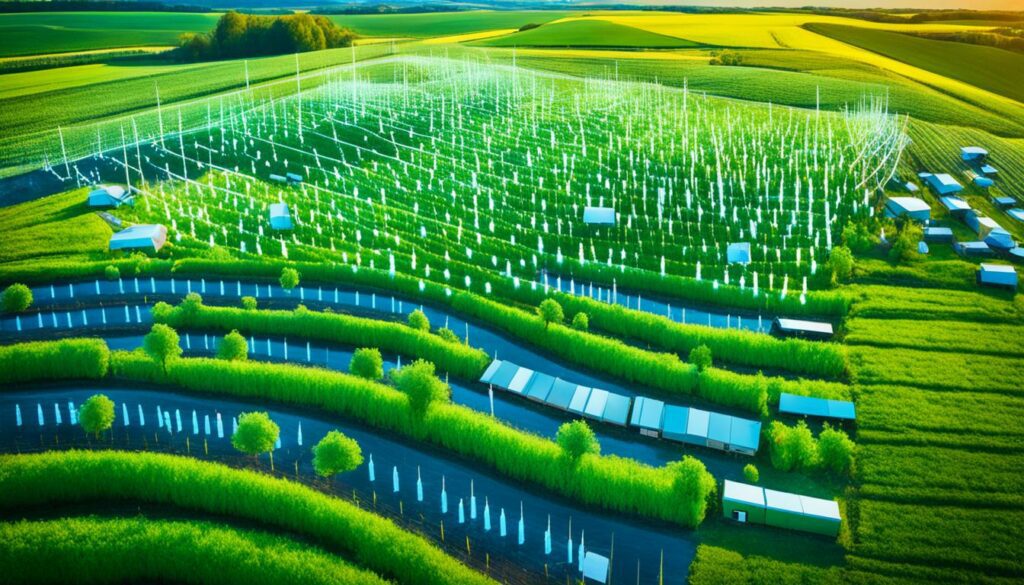
In precision crop farming, IoT tools watch over the soil, water, and crops. The IoT market in farming was worth $27.1 billion in 2021. It’s set to grow to $84.5 billion by 2031.
Livestock tracking is quickly becoming popular. It offers current information on animals’ health, position, and actions. This helps farms run more smoothly.
In 2021, big farms made up over half of the IoT farming market. Yet, smaller farms are catching up fast. They might grow at a rate of 14.0% yearly.
Handling all the farming IoT data is a big task. But, it’s getting easier with new tech. The market for farming IoT is booming, making better data tools necessary.
| Category | Revenue Share (2021) | Forecasted CAGR |
|---|---|---|
| IoT in Agriculture Market | $27.1 billion | 12.6% |
| Software Segment | One-third of market revenue | 14.0% |
| Large Farm Type Segment | More than half of market revenue | Dominance Expectation |
| Mid-Size Farm Segment | Fastest CAGR forecast | 14.0% |
Key companies like Decisive Farming Corp., Hitachi, and Farmers Edge work together. They aim to lead the market. Good data management is crucial for the IoT’s success in farming.
Looking at the emerging trends in agricultural tech, we see that automation and hi-tech tools are changing the game. Vertical farming stands out, using 70% less water than before. This saves water in a world where it’s running low.
Automation makes farming easier by handling repetitive jobs. This change makes farming smarter and more eco-friendly. Drones are flying high to watch over crops and collect important data.
Greenhouses are also advancing quickly. They use LED lights and smart controls to get the most from crops. They’re a key part of the $350 billion vegetable industry every year.
AI is shifting how farming is done. It makes checking on crops faster and more exact. Drones for farming will be worth $7.19 billion by 2032, showing just how smart our farms are becoming.
Blockchain is making food tracking better. It creates clear paths from farm to table, making food safer. Genetic tech is boosting livestock health and productivity. Tech is changing every part of farming.
These emerging trends are the future of farming. Programs like Plug and Play’s help new tech find its place in agriculture. Tools like the Agriculture Innovation Map let us see where farming is heading.
| Trend | Market Value/Impact | Growth Projection |
|---|---|---|
| Precision Agriculture | $43.4 billion by 2025 | Significant growth in sustainable practices |
| Greenhouse Market | $350 billion in vegetables annually | Tech-heavy advancements |
| Drone Market | $7.19 billion by 2032 | Enhanced monitoring and data collection |
| AI in Agriculture | $4.7 billion by 2028 | Increased accuracy in monitoring |
| Farm Automation | Increases operational efficiency | Rapid adoption for repetitive tasks |
Local and regional food systems are reshaping market research. They bring new insights about farming methods. This knowledge is key in understanding how farming affects the area and how food markets work. The trend towards locally grown food meets what consumers want. This brings new chances in country areas. It also shows why detailed market research is vital.
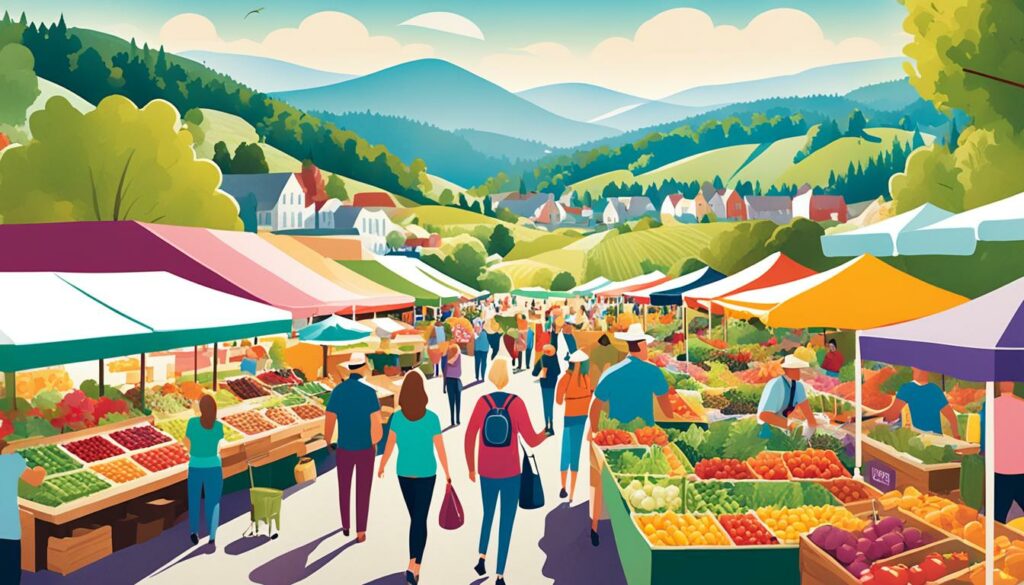
Small and medium-sized food makers meet big hurdles in local systems. They find it hard to find steady ways to sell their products. Efforts like the Small and Medium-Sized Farms project help. But, they need more help in researching markets. Knowing more about regional farming can guide them to sell better in more places.
Farmers markets play a key role in the local food scene. They are main sale points, connecting makers to buyers. This affects local farming a lot. Smart research about these markets shows how they shape what kind of food is made and sold. According to the USDA, the number of these markets jumped from 1,700 to over 7,800 between 1994 and 2012. This growth helps not just the local economy. It also follows the National Farm to School Network’s data that suggests over $13 million sales to local farmers yearly.
| Metric | Data |
|---|---|
| Increase in Farmers Markets | 1,700 to over 7,800 (1994-2012) |
| Estimated Sales to Regional Farmers | $13 million annually |
| Economic Impact of GusNIP | $85 million, tenfold increase since Year 1 |
Local food systems are changing the game in market research. These changes help not just small farms but all agriculture. They make sure local and small makers do well as more people want locally grown food.
Global agricultural trends are complex and always changing. They are shaped by how much each area can grow crops and by the flow of trade between countries. To succeed in this environment, we must grasp the different trends in each place and how move crops and farm goods across borders.
Each region differs greatly in using modern farming. In North America, where precision farming is advanced, there has been a boost in productivity. For example, there was a 4% increase in productivity from 2002 to 2018.
In Asia, the use of these technologies is far behind, with only a 9% adoption rate. Yet, in parts of Europe, like Germany and the Netherlands, 70% of farming machines use precision farming. This contrast shows the need for different strategies to encourage farming advancements around the world.
The way countries trade farm goods is a major influence on global farming trends. The increasingly popular precision agriculture is shaking up how countries interact. Worth $9.4 billion in 2022, this sector is growing fast.
Core technologies such as GPS, drones, and AI make farming more efficient. But, high costs and complex tech can be tough hurdles to cross. To help, governments offer subsidies, finance, and simpler tech options. The demand for digital farming is also growing, expected to hit almost $30 billion by 2028. This will further change how countries buy and sell farm products.
Let’s explore some key figures in a comparative table:
| Region | Adoption Rate | Technology Emphasis | Government Initiatives |
|---|---|---|---|
| North America | High | Precision farming, IoT | Subsidies, Financial Support |
| Europe | Very High | GPS, Sensors, Drones | Regulatory Support, Training |
| Asia | Low to Moderate | Smart Farming, Robotics | Government Priority, Financial Incentives |
| South America | Moderate | Remote Sensing | Government Initiatives |
| Africa | Emerging | Agritech Services | Investment in Agritech |
Understanding global agricultural trends means knowing how different regions farm and trade. This knowledge is crucial for farmers and traders to do well in the global market.
The global agricultural market is quickly changing. It’s all thanks to big investments in market research. This research aims to understand what people want in their food, how to create products sustainably, and to develop new items. Agricultural Market Research is a big part of global spending, with 8.5% going into it. This shows the industry’s keen on using the latest insights for farming and business.
The agricultural market’s big players include leading manufacturers. They are set on driving innovation and catching key market spots. The biggest markets, at USD 81.5 billion now, are expected to hit USD 94.3 billion in 2024. This would mean a significant yearly growth of 15.7%. These major companies are putting a lot of money into new fields. For example, the biostimulants sector might reach USD 7.6 billion by 2029. And the digital farming market could grow to USD 36.0 billion in 2028. This shows a promising trend of 10.3%.
Being aware of market shares is crucial in today’s market. It helps stakeholders know where they stand and where to go next. Understanding what consumers want is key. A big part of the research is looking into consumer behaviour.
Sustainability and environmental concerns are also front and centre. They make up 6.9% of the studies. Developing new products is a focus too, with 9.8% of research projects working on this.
Looking ahead, the market for organic fertilisers is expected to grow to USD 13.6 billion by 2029. The pet food ingredients market may hit USD 47.4 billion in 2028. These show the dynamic energy in the global agriculture world.
Market research in farming is key for those in the field to make smart choices. It looks at prices, volume, and more to help stay competitive. This is even more crucial in an ever-changing market.
They help forecast future trends by interpreting current market states. Knowing these metrics lets farmers and experts plan well. It’s like predicting the weather, but for markets.
Weather directly affects how much we grow, which affects what we can sell. It’s key in making plans for the agricultural industry. This is essential for anyone in the farming world.
The USDA Market News shares important price and sales data with everyone. This info is vital for understanding market trends. It helps farmers and others in the agriculture sector make the best choices.
Information from farms comes from surveys and watching the fields. Also, experts use reports that already exist. New tech like IoT and satellites have made gathering data more precise and efficient.
Prices change due to seasons, how much people want, and international trade. By studying these, farmers and traders can earn more and plan better. This is how they make their business choices.
Experts look at market patterns and what people are buying. Using predictions, they can guess what might happen next in the market. This helps in making smart changes.
Agribusiness studies deep dive into market movement, where to invest, and ways to run farms effectively. What they learn influences big decisions and new policies. It’s a big part of farming’s future success.
Getting surveys right in rural areas is tricky. There are wide areas to cover and not a lot of resources. It’s important to work through these issues to really understand and help local farmers.
To guess how much we’ll get next year, experts look at weather and how we’ve done in the past. These forecasts are very important for making plans and choices.
IoT has changed farming by making it easier to watch crops and animals. Collecting a lot of data can improve how we use our resources. It’s all about using technology for farming better.
Now, more machines do the work, drones fly over fields, and we try to grow tougher plants. These new things are making farming more efficient and innovative, guiding its future.
Small and medium farmers benefit from local systems. They connect with buyers at farmers markets, affecting what gets sold and bought. It shows how local choices can change the market.
Local abilities to grow food and how countries trade are big factors. By studying them, farmers can compete worldwide. It’s important for making it in the global market.
Big companies and top entities are in charge worldwide. Knowing who’s in the lead helps understand the market. It shows who has the most influence in agriculture.